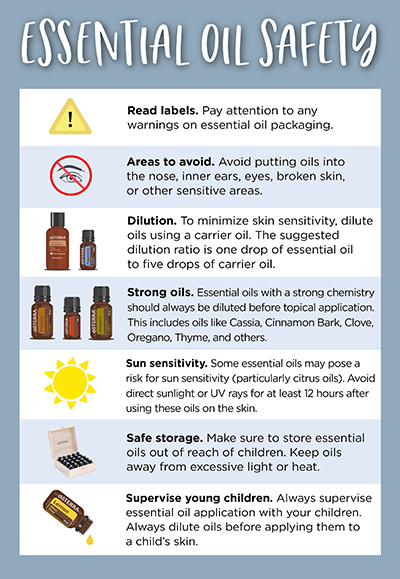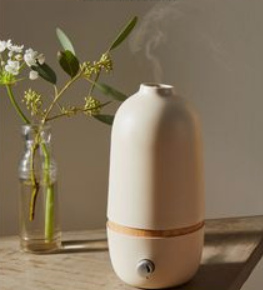The easiest way to purchase essential oils at the highest level: https://beta-doterra.myvoffice.com/yizharcohentzedek
Essential Oil Safety Guide

Are Essential Oils Safe?
Those who are new to essential oils often ask, “Are essential oils really safe?”
Essential oils have a long history of safe and effective use, for everything from personal hygiene and cooking to emotional benefits and health benefits.
When you use appropriate amounts of pure essential oils, they are absolutely safe enough to use at home for yourself and with your family. High-quality essential oils go through extensive purity testing to ensure safety.
Like anything else you’d use in your home or with your children, essential oils are safe when you adhere to recommended dosage amounts and use them within proper parameters. Among the many benefits of essential oils, one major advantage is that they offer peace of mind to those who worry about using chemical-ridden products for cleaning, cooking, and other daily tasks. Essential oils are a safe alternative to many of the products you see on grocery store shelves that contain synthetic toxins or chemicals that could be harmful.
Learning about proper use and dosage will allow you to safely use essential oils at home and with your family, while enjoying the benefits of a natural product.
How to Use Pure Essential Oils Safely
Before you use essential oils, know that not all oils are created equal. Typically, high-quality essential oils go through rounds of rigorous testing to ensure the product is safe to use. Not all companies use thorough testing methods, and many essential oil distributors will use synthetic fillers that alter the efficacy of the oils.
Only use essential oils that have been carefully produced and thoroughly tested to ensure safety for you and your family. For example, doTERRA essential oils are put through a meticulous testing process, where they are analyzed for potentially harmful contaminants and other substances that could compromise the safety or quality of the oil. It’s important to choose high-quality essential oils that have been tested and cleared for safe use before using them with your family.
Essential Oil Safety Guidelines
When it comes to using essential oils, there are a few safety guidelines you’ll want to abide by. Here are some of the best practices for safe essential oil usage:
- Always read the labels. Pay attention to any specific warnings on your essential oil packaging and adhere to any recommendations provided by the manufacturer.
- Avoid certain areas. Avoid putting oils into your nose, inner ears, eyes, broken skin, or other sensitive areas.
- Dilute oils. To minimize skin sensitivity, dilute essential oils using a carrier oil like fractionated coconut oil. The suggested dilution ratio is one drop of essential oil to five drops of carrier oil. Always dilute an oil when using it for the first time, applying it to sensitive skin, or when using essential oils with children. When using oils with a particularly strong chemistry, you will want to dilute one drop of essential oil to ten drops of carrier oil.
- Know your strong oils. Some essential oils should always be diluted with fractionated coconut oil before putting them on your skin. Some of these oils include Cassia, Cinnamon Bark, Clove, Oregano, and Thyme. Keep in mind, this is not an exhaustive list, so always pay attention to labels with warnings about strong oils.
- Be careful of sun sensitivity. Some essential oils can pose a risk for sun sensitivity, particularly citrus oils. Some of these oils include Bergamot, Green Mandarin, Grapefruit, Lemon, Lime, Tangerine, Wild Orange, and any essential oil blends that contain these oils. Again, this is not an exhaustive list. Before applying an essential oil topically, check the label for any sun sensitivity warnings. Avoid direct sunlight or UV rays for at least 12 hours following the use of these oils on the skin (this includes tanning beds).
- Practice safe storage. Make sure to store essential oils out of reach of children. This measure will help prevent accidental ingestion. You’ll also want to keep your oils away from excessive light or heat, as this can alter the chemical properties of an essential oil significantly.
- Supervise young children. Always supervise essential oil application with your children. Because children have more delicate skin, it’s a good idea to dilute oils before applying them topically. Try applying the oil to the bottom of a child’s feet before you try other areas. In addition to safe storage practices, you can also use Child Resistant Caps to ensure that your children don’t accidentally ingest oils on their own.
- Talk to a healthcare professional. If you have specific health concerns, consult with your doctor before using essential oils.
Avoiding Essential Oil Sensitivity
Safe use of essential oils varies from individual to individual. This is why it’s important to consider your own personal needs when it comes to safety. For example, some people have sensitive skin, which simply means that they will need to dilute more potent essential oils. In certain cases, you may need to refrain from using a particular essential oil if it causes sensitivity when you use it. However, you can often use a smaller amount of oil, or alter your application method to avoid sensitivity.
Is It Possible to Have an Allergic Reaction to Essential Oils?
Some people ask, “Can you have an allergic reaction to essential oils?” An allergic reaction occurs when the body experiences an abnormal immune reaction after exposure to a protein molecule that is typically harmless. CPTG Certified Pure Tested Grade™ essential oils are completely made up of aromatic compounds found in nature; they don’t contain any protein molecules, so they don’t cause allergic reactions in the same way that, for example, peanuts or eggs might.
However, with some people, essential oils can bind to proteins in the skin and create a type of molecule that the body may recognize as an allergen, creating an allergic response. This process depends on many things, such as the type and amount of oil being used, the person’s individual protein levels, and even genetics.
Sensitivity to an essential oil can cause responses in the skin, digestive system, respiratory system, and other areas of the body.
Signs of an essential oil sensitivity or allergic reaction include:
- Pain, swelling, or tenderness in the skin
- Skin irritation (such as itching, rash, or hives)
- Difficulty breathing
- Stomach upset
What to Do If you Experience a Reaction to Essential Oils
If you experience any of the symptoms listed above, it’s important to stop using that essential oil immediately so that you don’t make the reaction worse. It’s advisable to take a break from the application method that caused the reaction (for example, if you have a skin reaction, avoid topical use for a while) and choose other ways to enjoy the benefits of the oil.
For severe reactions, seek medical treatment if needed. doTERRA has a system that allows you to report any adverse reactions you might have. To report any adverse reactions, simply contact doTERRA Member Services.
Are Essential Oils Toxic?
Essential oils are safe to use, as long as the appropriate dosage and application methods are observed. In the most extreme cases, exceeding dosage recommendations for oils can lead to toxicity. Toxicity is when a substance reaches a point that it becomes harmful or damaging to the body. Any substance can become toxic if used in an inappropriate dose. Even natural, seemingly harmless substances like water, minerals, or vitamins, can become toxic when used or consumed in excess.
How to Handle Essential Oil Sensitivity
Essential oil safety from doTERRA International LLC
If you develop a sensitivity to an essential oil, you can make a few adjustments to avoid further sensitivity or discomfort. Since sensitivity to an essential oil isn’t the same as an allergic reaction, you may still be able to use that essential oil with a different form of application.
For example, if you experience sensitivity after using an essential oil internally, you may still be able to use it aromatically or topically. Essential oil sensitivity can also be caused by dosage. If you’ve experienced sensitivity with a particular essential oil in the past, you might try diluting the oil, or simply taking a smaller dose to see if the sensitivity was caused by a higher dosage.
Aromatic essential oil sensitivity
If a reaction occurs from inhaling a diffused essential oil, immediately turn off the diffuser and remove yourself from the area of diffusion. If leaving the area is not possible, increase air circulation by opening a window or air vent. Seek medical attention if the sensitivity is severe or prolonged, or if breathing becomes difficult.
Topical essential oil sensitivity
If a reaction occurs on the skin, discontinue use immediately. The irritated area can be soothed with a carrier oil such as Fractionated Coconut Oil. Gently wipe the area with a soft cloth to draw out and remove as much essential oil as possible. Alternate between adding coconut oil and gently wiping the area. The skin will need time to calm down, which may take hours, days, or weeks, depending on the severity of your body’s sensitivity response, as well as amount of oil used. Seek immediate medical attention if the sensitivity reaction is severe or worsens over time.
If the reaction occurs in the eye, immediately rinse it. Because essential oils are not water soluble, water will not be effective for removing the essential oil. Fat-containing milk (not skim milk) is a great alternative. The eye should be flushed multiple times until irritation ceases. Then seek medical attention from a trained professional to ensure no long-term damage has occurred.
Internal essential oil sensitivity
If a reaction occurs in the digestive system, immediately discontinue use. Signs of a digestive system reaction include abdominal pain, nausea, vomiting, or diarrhea. If a large amount of oil was consumed, contact poison control immediately. If only a small amount was consumed, drink plenty of fluids—preferably milk or another fat-containing drink—to minimize the upset. Seek medical attention if the reaction is severe or prolonged.
Essential Oil Dosage Guidelines
How Do I Know How Much Essential Oil to Use?
It’s important to remember that pure essential oils are very potent and that each individual will have a different reaction to each oil. For this reason, it is best to follow usage recommendations on the oil bottle or packaging. In most cases, it is best to start with a single drop and slowly increase the amount over time.
The amount of essential oil you use will depend greatly on your own personal health status and your level of experience with essential oils. To remain within the parameters of safe usage, always consider the advice of your healthcare provider before using essential oils. When using an essential oil, always follow the proper usage guidelines to help you prevent overwhelming the body with incorrect essential oil levels.
Essential Oil Guidelines: Aromatic Use
Essential oil diffusion is a safe and effective way to enjoy the benefits of essential oils when appropriate levels are used in well-ventilated spaces. Diffused essential oils have long been studied for their ability to enhance feelings of relaxation, encouragement, excitement, focus, or well-being.
As with all application methods, diffusion should be used in smaller doses and multiple times throughout the day to achieve maximum benefits. The amount of oil diffused, proximity to the diffuser, and size of the room will determine how long an oil should be diffused. The more oil used in closer proximity to the diffuser, the more potent the effect will be. If you’re using a water-based diffuser, it’s generally recommended to use 1–10 drops of oil per diffusion period. Higher drop amounts are appropriate for larger areas, like big rooms or outdoor spaces. Start with short diffusion periods (15–20 minutes), and then increase the time as needed to achieve the desired benefits.
Essential Oil Safety Guidelines: Topical Use
Is It Safe to Use Essential Oils On the Skin?
Topical application is an efficient way to use essential oils for a localized effect. Because essential oils are a lipid-soluble substance, they can easily penetrate the skin.
As with any product you use topically on your skin, (lotions, creams, makeup, and so on), there are a few safety precautions that will allow you to take advantage of the benefits of essential oils and avoid irritation or sensitivity. Essential oils are useful for promoting healthy-looking skin, creating a relaxing massage, and more, but it’s important to follow safety guidelines to ensure proper use. Once you discover how each oil reacts with your body, you can determine how to safely and effectively enjoy the topical benefits each oil has to offer.
Because essential oils are so potent, it’s always advisable to use several small doses throughout the day rather than a single large dose. Start with the lowest possible dose (one to two drops), and then increase the dose as necessary to achieve the desired benefit. A topical dose can be repeated every four to six hours as needed. If you’re trying an oil for the first time, consider diluting it with a carrier oil like Fractionated Coconut Oil before application to see how your skin responds. Because every individual is unique, the dose will vary for each individual based on size, age, and overall health status.
How to Dilute Essential Oils
When it comes to safe topical use of essential oils, dilution is one of the most important principles to understand. Some worry that diluting an essential oil before applying will take away its benefits; however, dilution actually makes for better absorption into the skin—extending the benefits for even longer. By diluting an essential oil with a carrier oil, you slow the rate of evaporation, enhance absorption into the skin, and protect against sensitive or delicate skin. In reality, dilution doesn’t take away from the essential oil experience. Rather, it allows for more effective topical application.
You experience many benefits by diluting essential oils. Dilution increases the amount of skin, or surface area, on which the oil is applied and absorbed. It also enhances absorption through dry skin and minimizes possible sensitivities. It’s never wrong to dilute oils, especially when using oils with a more potent chemistry, such as Cassia, Cinnamon, Clove, Oregano, Thyme, and others.
While essential oils absorb easily into the skin, you can increase absorption and extend benefits by massaging the oil into the skin or by using a carrier oil that will moisturize the skin as the oil absorbs.
When diluting essential oils, try starting with one drop of essential oil combined with one to five drops of a carrier oil, such as Fractionated Coconut Oil. Feel free to adjust this ratio to meet your specific needs, taking into account your personal preferences, the oil’s chemistry, and your personal sensitivity.

Essential Oil Safety Guidelines: Internal Use
Is It Safe to Ingest Essential Oils?
When used appropriately, essential oils offer many wonderful internal benefits. Know that there are certain essential oils that should never be used internally. However, there are plenty of essential oils that have been approved for internal use, which will provide the body with a variety of powerful benefits. Always refer to the directions and instructions on the label before ingesting any oil.
If you’ve never used essential oils internally before, it might seem strange to consume something so powerful and potent. However, pure essential oils are derived from abundant plants in nature, offering a wide spectrum of benefits when used internally. You’re most likely already incorporating essential oils into your daily diet, as many of the foods we eat contain small amounts of essential oil.
Because our bodies are designed to metabolize and process compounds found in nature, we are already equipped to metabolize essential oils. Essential oils are merely high concentrations of natural compounds—the parts that give plants their taste and smell. While some essential oils are never appropriate for internal consumption, plenty of oils can be safely taken internally and processed by the body.
How to Use Essential Oils Internally
When using essential oils internally, it’s important to regard them with as much precaution as any other supplement. Start with the lowest possible dose (one to two drops), and then increase the dose as needed.
At a certain point, taking a higher dose no longer adds benefits. If you take too much, it can even become harmful. It’s better to take a smaller dose, which can be repeated every four to six hours as needed. In total, typically no more than 20 drops, divided into doses, should be consumed in a 24-hour period. The maximum dose may be lower or higher for some oils. A lower daily dose is recommended for extended internal use. Remember, some essential oils are not intended for internal usage—this is why it’s of vital importance to read all labels before consuming.
Essential Oils and Children
Is It Safe to Use Essential Oils on Children?
Because children are smaller and more sensitive than adults, it is important to understand that the rules of essential oils are different for children than they are for adults. Once you educate yourself on the safety guidelines required for using essential oils with children, it’s easy to help your kids reap the benefits that oils have to offer. If your children have specific health conditions or concerns, consult with their physician first.
While special precautions should be taken when using essential oils around children, parents can still be confident that it’s safe for children to use essential oils.
When you’re ready to use essential oils with your children, keep a few safety guidelines in mind:
- Adjust application methods. Always give a child smaller doses of essential oils than you would an adult. Before you use essential oils around your children, think about how you might adjust the dosage so that it’s appropriate for the child.
- Dilute. Because children have sensitive, delicate skin and developing bodies, you should always dilute before applying essential oil to a child’s skin. Start with one drop of oil and 10 drops of a carrier oil like Fractionated Coconut Oil. When trying a new oil with your child, apply the oil to the bottoms of their feet. The feet are a nonintrusive, less sensitive area, providing the perfect place to apply essential oils on young or delicate skin.
- Discuss essential oil safety with your children. It can be difficult for children to understand just how potent and powerful essential oils are. Make sure your children know that it’s not appropriate to drink essential oils or apply them without adult supervision. Remember, caps can come off and bottles can break, so keep oils out of reach of children. Educating your children about essential oil safety guidelines will help promote safe usage within the home.
If you want to teach your children about essential oils and how they work, download this fun interactive workbook designed just for kids: doTERRA Science for Kids.
Essential Oils and Pregnancy
Is It Safe to Use Essential Oils During Pregnancy?
Essential oils can help maintain a healthy body, support the immune system, soothe feelings of discomfort, and more.* Because of these powerful benefits, essential oils are useful and effective during every phase of life—even pregnancy. By following proper safety guidelines, you can feel confident in using essential oils during pregnancy.
When pregnant, the body goes through a wide variety of changes. These changes often bring feelings of discomfort and sensitivity. While every pregnancy is different, the goal is the same: to support the healthy, proper function of the entire body. Along with proper nutrition and regular exercise, essential oils can be used during pregnancy to help support a healthy body and healthy baby. You can also use essential oils during labor and delivery to make it a more pleasant or positive experience.
Essential Oil Safety Guidelines for Pregnancy
Due to the ethical issue of testing expecting mothers and their fetuses, limited clinical studies address the safety of essential oils during pregnancy. However, we can rely on the history of safe use to determine which essential oils to use during pregnancy.
During pregnancy, it’s not uncommon for a woman to be sensitive to essential oils. Due to these sensitivities and all of the changes that occur in the body when pregnant, it would be wise to consult with your doctor before using essential oils during pregnancy.
Talking to your doctor about using essential oils while pregnant
Even if you’ve used essential oils before without incident, you should still inform your doctor of any essential oils you plan to use during pregnancy. Your doctor knows you, your specific health concerns, and the status of your pregnancy; therefore, he or she should be aware of all essential oil products you plan to use during pregnancy.
Because each pregnancy is different, your doctor is the best resource available for making a treatment plan and determining which essential oils are best to use during pregnancy for each individual. Your doctor can give you a good idea of what to avoid during pregnancy, as well as any other safety measures you should take, based on your personal health and the health of your growing baby.
To learn more about essential oils and pregnancy, read this article: “How to Use Essential Oils during Pregnancy.”
Is It Safe to Use Essential Oils While Breastfeeding?
In addition to concerns about essential oils and pregnancy, many people ask, “Is it safe to use essential oils while breastfeeding?” While the body changes significantly during pregnancy, these changes don’t end with the birth of the baby—your body continues to change as you adapt to post-partum life. Just as you should discuss beforehand the use of essential oils with your doctor for pregnancy, you’ll also want to consult with your physician if you choose to nurse.
Again, your doctor is the best resource you have for advice when it comes to your body, your baby, and any special concerns you might have. Just as you would check with your doctor before using any new products when breastfeeding, it’s important to discuss your essential oil use with your healthcare professional when you become a nursing mother.
Like pregnancy, breastfeeding places a lot of demands on a mother’s body. When nursing, the goal is to maintain a strong and healthy body and support a growing newborn. With the help of your doctor, you can use essential oils and essential oil–related products that support the whole body.
Essential Oils and Animals
Is It Safe to Use Essential Oils around Pets?
While there is some controversy surrounding the essential oils on animals, when used properly, essential oils can be part of a well-rounded program to help your pets live happy, healthy lives. Just as it is of key importance to use pure essential oils on yourself and your family, you should use only high-quality, pure essential oils with your pets.
Essential oils have numerous benefits for your pets. They can help with calming emotions, soothing muscles, deodorizing unpleasant aromas, and maintaining overall wellness for your furry family members. As with any new product you introduce to your pet, begin slowly.
- Start small. Start with a small amount of a diffused or diluted essential oil, and then observe your pet’s behavior.
- Diffuse. Keep your diffusers in a safe place where your pet can’t knock it over. When you’re diffusing, be sure to use a water-based diffuser and only diffuse four to five drops at a time in an open area, where your pet can leave the room if desired.
- Dilute. Before using oils topically on your pets, first consult with your veterinarian. Always dilute essential oils down to 1–2 percent (100 drops of a carrier oil for every one drop of essential oil) before topical application. Dilute even more for animals under 10 pounds.









